Using Simulation to Coordinate Care for Cardiac Surgery
Using Simulation to Coordinate Care for Cardiac Surgery
By Alistair B. M. Phillips, MD; and Russell D. Metcalfe-Smith
Photos courtesy of Cedars-Sinai
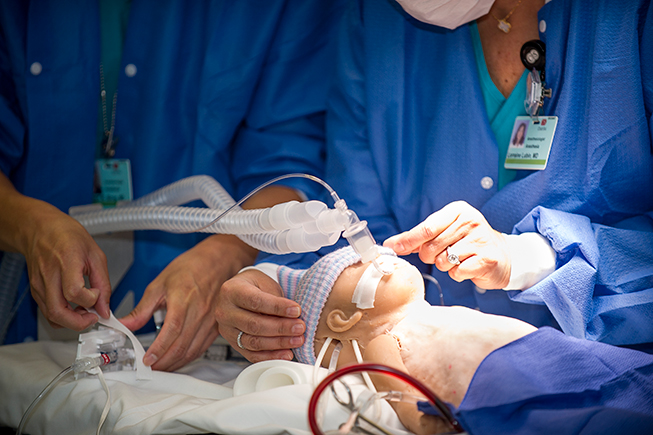 A six-month-old girl is undergoing repair of a hole in her heart, and while on cardiopulmonary bypass (the machine that pumps the blood through the body while the heart is stopped), there is massive bleeding from the heart, which makes it impossible to repair the defect. The team moves quickly to correct the problem in a timely fashion, avoiding injury to the patient. Shortly thereafter, the oxygenator fails, and the team responds quickly and effectively. The only difference between this patient and the patient the team will see next week is that this one never breathes and is not alive; she is a specialized mannequin. Because of this training, the team is confident and prepared to respond to minor and major problems in an effective, efficient manner, which leads to fewer errors, improved patient care, and enhanced patient safety.
A six-month-old girl is undergoing repair of a hole in her heart, and while on cardiopulmonary bypass (the machine that pumps the blood through the body while the heart is stopped), there is massive bleeding from the heart, which makes it impossible to repair the defect. The team moves quickly to correct the problem in a timely fashion, avoiding injury to the patient. Shortly thereafter, the oxygenator fails, and the team responds quickly and effectively. The only difference between this patient and the patient the team will see next week is that this one never breathes and is not alive; she is a specialized mannequin. Because of this training, the team is confident and prepared to respond to minor and major problems in an effective, efficient manner, which leads to fewer errors, improved patient care, and enhanced patient safety.
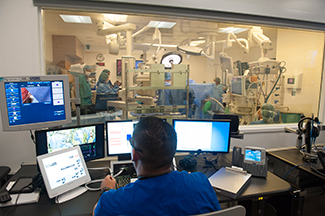 |
|
| Simulation control room |
The congenital heart program at Cedars-Sinai Medical Center began using the Women’s Guild Simulation Center for Advanced Clinical Skills in October 2013 to foster a team-based approach across the entire surgical day experience. This approach transcends the surgical procedure and allows for goal alignment and team-based decision making over the entire continuum of the patient care team. The methods we use improve team communication, team confidence, patient care, and patient safety. Because we care for critically ill patients with complex medical problems over several care areas, including the operating room and intensive care unit, the development of a culture of open communication centered on goal alignment is critical to ensure safe and effective care. Team training that simulates an entire surgical scenario from preoperative preparation to surgical intervention to recovery ensures the team is able to respond effectively and efficiently, with the ultimate goal to return the patient healthy and unharmed.
Cedars-Sinai Medical Center in Los Angeles is a comprehensive medical facility with over 900-beds and is the largest hospital in California. The Guerin Family Congenital Heart Program cares for more than 100 patients each month, spanning conditions from fetal diagnosis to children with congenital heart disease, children and adolescents needing sports clearance, to adults with complex congenital heart disease, who may require care for advanced heart failure. For patients with advanced heart failure, treatment can include mechanical circulator support and heart transplantation. To care for all our patients, we have developed a multidisciplinary team that includes surgeons, anesthesiologists, nurses, allied health providers, intensivists, pediatric cardiologists, adult cardiologists, interventionists, and perfusionists. Our overall goal is to improve the value of healthcare over the patient’s entire lifetime by decreasing the impact of therapies as well as reducing the need for interventions.
Women’s Guild Simulation Center for Advanced Clinical Skills
The Women’s Guild Simulation Center for Advanced Clinical Skills at Cedars Sinai Medical Center consists of approximately 10,000 square feet and incorporates two fully functional environments that comprise operating rooms and intensive care units (ICUs), as well as OB-GYN, trauma, and pediatric facilities. Technology at the center allows digital recording and live transmission of the simulation. The recordings can be analyzed and interpreted for complex human interactions.
The center proactively engages entire clinical disciplines and brings together professionals from across the organization. An important strategy has been to replicate reality—allowing “full immersion”—and stress the importance of using simulation to proactively identify latent errors. The simulation center can also be used to evaluate actual clinical events. The engagement of educators, clinicians, as well as risk management and patient safety professionals truly allows for maximal benefit.
Healthcare simulation is a technique associated with the management of acute medical emergencies and is often viewed as a tool for the development of associated skills. In its simplest form, this educational approach has been in existence for decades. The development and use of technology is slowly being accepted in the field of team-based education.
Many institutions have been slow to engage with this style of medical education despite the fact that adults tend to be reflective learners, and debriefing is a key part of the educational process in simulation. Adults working as a team are much better off understanding and learning from situations, rather than abstract interpretation. The term simulation suggests replicating reality, but often falls short of achieving that experience, which may contribute to participants not engaging fully in these valuable learning experiences. Developing technology allows for a greater level of realism, which reduces the need to suspend reality, therefore creating for the participant a greater sense of realism.
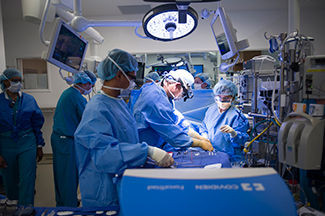 |
|
| Complex team-based care of a critically ill baby. |
Importance of Team Approach
As with most fields in medicine and surgery, the team approach is vital in the congenital heart operating room, where we have at least nine healthcare providers actively involved in managing the patient. These include surgeons, pediatric cardiac anesthesiologists, congenital perfusionists, surgical technicians, and specialized operating room nurses.
It is important that all care providers understand the goals and overall plan for the patient.
We run the entire simulation day as if we were taking care of one of our actual patients. We have the same preparation. The Women’s Guild simulation center is so realistic, we don’t have to suspend reality, which is crucial to the success of building a cohesive team that works together to solve problems. Fortunately, the events we simulate are very rare. Being in an environment that is completely real, our team is immersed, which helps us understand barriers to communication, improve workflows, appreciate each other’s expectations, and comprehend the challenges we each face. Nurse practitioner Marion McRae says, “Team-based learning teaches team-functioning skills, which are important as healthcare professionals function in teams. We can bring together several healthcare professionals who have never worked together, and they have to learn to negotiate a consensus approach to how they will provide care.”
Goal Definition: Setting the Stage for Simulation
A multi-pronged strategy ensures that everyone on the team understands the goals and expectations for each patient:
- A preoperative briefing report outlines the patient’s medical condition and history, perfusion technique to be used, operative sequence, equipment needs, blood bank needs, lines needed for access, and expected surgical plan. The report is distributed the day before the procedure.
- A team huddle the morning of the surgery allows everyone to review together the patient’s condition, surgery goals, anesthesia goals, perfusion goals, nursing goals, and equipment needs. During the team huddle, we have a “no distraction” conversation of the goals set forth to have goal alignment, prioritization, and stratification. The key to this approach depends on open communication. (A sample of the “huddle sheet” is included in the online version of this article at http://psqh.com/usc3s.
By using team huddles, we are able to the set the stage for the upcoming procedure and, most importantly, align individual goals into team goals. Huddles also help build a collaborative approach, thereby improving communication in the operating room. It has been shown that minor communication lapses can lead to significant adverse events (Wahr et al., 2013). These communication breakdowns can be divided into several different forms, including barriers to communication, poor individual understanding of the need to communicate, and poor understanding of the goals for the patient.
We prepare for simulation as if it were a routine day. The environment is similar to what we are used to, and the preparation is the same. The patient has a name and medical history. We have a plan for the patient. We send out a briefing report and complete a team huddle prior to starting.
Preparing for the Unexpected
AHA Scientific Statement |
|
Patient Safety in the Cardiac Operating Room: This team-based approach is in keeping with a recent scientific statement from the American Heart Association (AHA) on improving communication in the cardiac operating room to reduce errors. In this review, the six “Cs” summarize the key elements that are needed: Communication, Cooperation, Coordination, Cognition (collective knowledge |
Our state-of-the art simulation center includes a SynDavar™, a specially designed simulator with a congenital heart defect and circulatory system, which allows teams to develop surgical scenarios that include all aspects of communication included in the American Heart Association’s recent scientific statement (see sidebar).
We are able to change scenarios and introduce very real, if infrequent, disasters. This unique environment tests the team’s response as a cohesive unit. We can change the patient’s vital signs, ventilation, and perfusion. We share the same primary goal of the safe return of the patient to the family; however, each group has sub-goals and varying opinions on how to attain the primary goal. By first having the pre-brief report, individuals are able to prepare for the upcoming procedure and think about their own goals. The team huddle allows for goal alignment and stratification. During the simulation, we can test different aspects of communication; teams with excellent goal alignment and understanding will respond to significant events in a timely and smooth manner, decreasing possible negative effects to the patient.
Using the SynDavar™, we are able to ensure the whole team is able to respond to rare disasters while engaged in a significant task, such as repairing a hole in the heart on bypass. Among other things, we are able to flood the field with blood, simulate an oxygenator failure, an injury to a major blood vessel, or a cannulation or airway issue. We are able to see how the team responds when the unexpected happens. This training allows the team to respond to adverse events more quickly in the real operating room and to learn to communicate more succinctly, with improved goal alignment. Dr. Constantinos Chrystostomou, director of the congenital heart ICU at Cedars-Sinai Medical Center, says, “With simulation of the procedure, operating time decreases, efficiency increases, and errors decrease.”
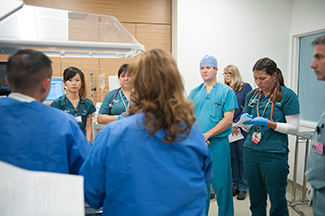 |
|
| Team handoff in the simulation center after finishing the repair of the ventricular septal defect. | |
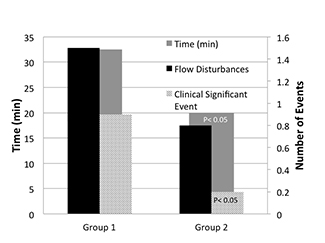 |
|
| Figure 1. Benefits of Team Handoffs in Congenital Heart ICU | |
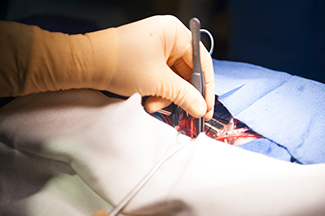 |
|
| Closing the ventricular septal defect (a hole in the heart) in the mannequin as the field fills with blood. The team worked together to quickly correct the problem in order for the surgeon to close the hole. |
Team Handoffs
After the surgical simulation, we are able to transport the patient to the ICU simulation, where separate medical personnel must seamlessly assume control of the patient. This new medical team consists of intensivists, nurses, respiratory therapists, cardiologists, and other allied medical providers. During this handoff, there must be clear communication of the patient’s current state as well as clearly defined key goals and expectations. To communicate these points concisely, the ICU team must be aware of the patient’s condition prior to surgery and clearly understand what transpired in the operating room.
Both the OR and ICU teams must work cohesively to provide the utmost level of care and to respond to changes in the medical conditions of the patient who has just undergone open heart surgery and is likely to be in a critical state, requiring precise management decisions. We are also able to change the patient’s physiologic state and simulate real-life rare disasters such as ventricular arrhythmias, cardiac arrest, significant bleeding, and tamponade. We can also simulate less disastrous events such as decreased urine output and slow bleeding from the chest tube.
Persuasive evidence supports the efficacy of this approach: With the introduction of a formalized hand-off process in congenital-heart intensive care, we were able to significantly reduce clinically significant events at six hours post-operatively.
We compared the clinical information in two groups; group 1 (n=16) used a traditional ICU transition from operating room to ICU, and group 2 (n=13) after the implementation of an enhanced team-handoff process. The time to complete the handoff was significantly reduced, as well as the number of clinically significant events at six hours (Figure 1).
Facilitated Debriefing and Reflection
After completing the simulation, the entire team (operating room and ICU) meets to analyze the day and to identify communication failures, workflow disturbances, and equipment issues. We are able to analyze video, our time-to responses, and actual dialogue. The team is able to develop an understanding and review with goal of improved care.
Reflection is a crucial component of the overall learning experience. Through careful facilitation of the debriefing process, significant lessons can be learned. Actual simulations can take considerable time, as does the reflection period. Those who are new to the process often attempt to reduce this learning period, however, that approach is likely to impact negatively on allowing the entire team to engage and work as a cohesive unit to learn important lessons.
The key point of learning will take place during the debrief. The skills needed to conduct these multi-professional debriefings should not be underestimated. Ensuring that participants feel equal and have permission to communicate their true feelings is essential. Healthcare’s traditional hierarchy is well known and impacts team-based communication. Enabling active participation relies on the facilitators to create a safe environment that allows for anyone within the team to express their concerns. Our approach to the proactive use of simulation in the congenital heart program is based on the active encouragement of effective communication by the entire team. The use of professional titles is reduced, creating an environment where first names are used and communication is enhanced.
De-emphasizing the role of the individual and focusing on actual events are important when difficult discussions are required. Learning is a process, a process that not only addresses actions and results but also digs deeper into why actions occurred. When we use debriefing, we attempt to affect change in people’s belief systems and approach, which requires facilitators to understand why events occurred as they did. Not only is the approach we use complex, the learning aspect during reflection can identify many issues that were not previously realized. New approaches to care can result from engaging the team and improving patient care and safety.
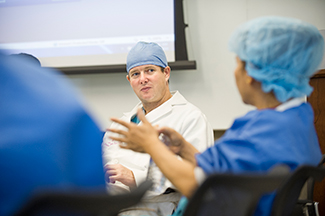 |
|
| Team debrief: operating room nurse discussing with surgeon issues during the procedure. |
Medicine is a rapidly changing field with increasing technology demands and improved equipment that have the benefit of improving outcomes for patients. These improved technologies can affect workflow in the operating room and may affect communication. Using the simulation center, we can introduce new technologies and equipment and evaluate the effect on the team dynamic, communication, and improved workflow.
In the operating room and the ICU, we are able to develop team-based learning and develop a culture of communication centered on goal alignment. Using a complete surgical scenario from preoperative evaluation to operating room to ICU, we are able to ensure that the entire care team responds effectively and works to the greatest goal of returning healthy and safe, be it babies to their parents, or husbands and wives to their spouses, or grandparents to their families. No matter who the patient is or what care they require, we will be prepared to delivery the utmost in patient care and quality of care. The six-month-old girl we operated on the week following the simulation did very well and was returned to her parents healthy and unharmed.
Alistair Phillips is co-director of the Guerin Family Congenital Heart Program and chief of the division of congenital heart surgery in the department of surgery at Cedars-Sinai Medical Center in Los Angles, California. Prior to coming to Cedars-Sinai, he was surgical director, heart transplantation and adult congenital heart disease at Cincinnati Children’s Hospital. He received my undergraduate degree from The Johns Hopkins University in biomedical engineering and a medical degree from The College of Physicians & Surgeons of Columbia University. After completing general and cardiothoracic surgery as well as two years of research generally focused on cardiac physiology at New York Presbyterian – Cornell Medical Center, he went onto New York Presbyterian – Columbia Medical Center where he completed fellowships in pacemakers/ defibrillators and pediatric cardiac surgery. His is board-certified in surgery, thoracic surgery and congenital heart surgery. Phillips is interested in developing novel approaches to treating congenital heart disease, mainly through a hybrid approach, and developing a team-based approached to delivering the uttermost level of care at the best valve. Over the last few years he has developed a translational research team with emphasis on improving the quality of care for our patients and improving long-term outcomes, with the believe that teamwork and communication are at the cornerstone of improved care. He complete the Intermountain Advanced Training Program in quality improvement with a thesis on using pre-operative team huddles to improve communication in the OR to reduce blood utilization. He may be contacted at 310.423.1153, email: alistair.phillips@cshs.org, and http://www.cedars-sinai.edu/Patients/Programs-and-Services/Heart-Institute/Centers-and-Programs/Congenital-Heart-Disease-Program/
Russell Metcalfe-Smith is the manager of the simulation center at Cedars-Sinai Medical Center in Los Angles, California. Prior to joining Cedars-Sinai Medical Center, he worked at Croydon University Hospital NHS Trust as both their clinical lead for resuscitation and their simulation center manager. Russell has an extensive background in both in and out-of-hospital resuscitation and has delivered advanced resuscitation programs to professionals internationally. A registered paramedic in the U.K. and U.S., Metcalfe-Smith holds a BSc (Hons) in healthcare development, and his post-graduate work has focused on both prevention of cardiac arrest and medical and healthcare simulation. He holds a fellowship from the Higher Education Authority and is a fellow of the Royal Society of Public Health. His passion is focusing on breaking down professional barriers in healthcare. He may be contacted at 424.315.4425, email: Russell.metcalfesmith@cshs.org.
Phillips, A. B. M., & Metcalfe-Smith, R. D. (2014). Patient Safety & Quality Healthcare, 11(6), 30–36.
References
Wahr, J. A., Prager, R. L., Abernathy, J. H., Martinez, E. A., Salas, E., Seifert, P. C.,…Nussmeier, N. A. (2013). Patient safety in the cardiac operating room: Human factors and teamwork. A scientific statement from the American Heart Association. Circulation, 128, 1139-1169. Retrieved from http://circ.ahajournals.org/content/128/10/1139
